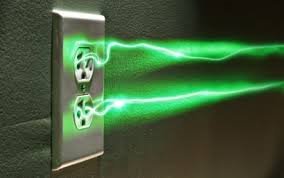
“Dirty electricity” has been on the march again. Before moving on the rest of this article, and to prevent the standard messages and emails I get when I post something about ‘dirty electricity’, let me point out that I have no beef with the concept (other than that I very much prefer the term ‘high voltage voltage transients). I very much doubt it has the health impact attributed to it by a number of devout followers, if any at all, but in my opinion it is worth further study.
So, with this out of the way, I also very much believe further studies shouldn’t be of the “scientific quality” (if you read this quickly, note it is between marks and in italic to indicate a bit of cynisism) of the papers published to date. Occasionally papers claiming a link between ‘dirty electricity’ and some adverse health effect get published; i think it is fair to say that these are written by one of a fairly small group of researchers and that, well, there is room for improvement. I wrote a review about these studies in 2010 discussing the obvious and significant flaws in all the papers up to 2010 making them useless for any conclusions on biological activity (link). Indeed, it has been pointed out to me that they were peer-reviewed, which should give them some scientific credibility. It is really beyond me how these ever got through the peer-review process but it must have including an unfortunate combination of a laissez-faire approach to the concept of peer review and very (very!) sympathetic reviewers. Anyhow, the world has moved on since 2010 and a new set of papers on dirty electricity have been published in the journal Electromagnetic Biology and Medicine; all by the same author. Unfortunately, the quality isn’t much better.
In fact, things have gotten worse…
I tend to think that this may come from a second unfortunate combination of “honest conviction that this is a public health problem”, “enthusiasm to study the subject” and “attempts to keep the subject in the lime light. Unfortunately, this is further hampered by a lack of funding to properly study the subject. Nonetheless, that still doesn’t excuse the attempt of trying to push rubbish as if it were good, scientific and peer-reviewed epidemiological work. Nor does it excuse the inherent flaws in journal’s peer-review processes that should be addressed.

My friend and colleague Igor Burstyn from Drexel University and I recently wrote a letter to point out the, very obvious, flaws in a paper entitled “Evidence that dirty electricity is causing the worldwide epidemics of obesity and diabetes.”, and can be found here (link). The paper is quite amusing (although I doubt it was meant as such), and we aimed to make our letter equally amusing (although, depending who you ask, we may or may not have succeeded in this). This letter has recently been published and can be found here (link), and so can the author’s reply here <link>. The reply suffers from selective quotation and misinterpretation; like unfortunately many of the papers on dirty electricity. If you can, have a read. It’s entertaining if nothing else…
 Anyway, while working on that paper we came across another paper by the same author (but co-written with a colleague (friend?) this time) that slipped through the peer-reviewing process of the journal Electromagnetic Biology and Medicine; entitled “Dirty electricity, chronic stress, neurotransmitters and disease.” (link) The paper, again, suffers from misinterpretation of the data on which you can read a bit further down this article. However, a much more serious problem in this paper, and something I believe needs a lot more attention was that the authors declared no Conflicts of Interest (COI). That was very surprising, given that the co-author of the paper (Stetzer) developed and sells the (allegedly only good…of course) equipment to measure dirty electricity in your homes as well as the equipment to allegedly clean your environment of these. Dr. Milham, the other author, has a very prominent position on the company’s website, so can also hardly be called independent either. If this situation would arise in papers published by authors with links to “big pharma” or “industry” it would have (and rightfully so!) led to, hopefully, retraction of the paper. Omission of such clear COIs just cannot be accidental oversights; especially not when the interpretation of the data is clearly biased….and we don’t even know how this could have influenced study design, data collection, etc.
Anyway, while working on that paper we came across another paper by the same author (but co-written with a colleague (friend?) this time) that slipped through the peer-reviewing process of the journal Electromagnetic Biology and Medicine; entitled “Dirty electricity, chronic stress, neurotransmitters and disease.” (link) The paper, again, suffers from misinterpretation of the data on which you can read a bit further down this article. However, a much more serious problem in this paper, and something I believe needs a lot more attention was that the authors declared no Conflicts of Interest (COI). That was very surprising, given that the co-author of the paper (Stetzer) developed and sells the (allegedly only good…of course) equipment to measure dirty electricity in your homes as well as the equipment to allegedly clean your environment of these. Dr. Milham, the other author, has a very prominent position on the company’s website, so can also hardly be called independent either. If this situation would arise in papers published by authors with links to “big pharma” or “industry” it would have (and rightfully so!) led to, hopefully, retraction of the paper. Omission of such clear COIs just cannot be accidental oversights; especially not when the interpretation of the data is clearly biased….and we don’t even know how this could have influenced study design, data collection, etc.
Most people by now are probably familiar with Ben Goldacre, who wrote a whole book about these issues in relation to the pharmaceutical industry (if you haven’t read it, you should. Find it here). Of course the field of dirty electricity is if of course much smaller and stands in no comparison to “big pharma”, a lot of money is still being made, and practises like this are unethical; full stop.
So, we came across this. Were very surprised, and wrote a letter to the editor pointing this out. After it got accepted the authors submitted a revised COI statement. So far so good…

…and then we were informed that the informahealthcare lawyers had come in and said that, since a revised COI was submitted, there was no need to publish our letter anymore. Very dodgy indeed! Not only will the flaws in the study now not be published, but also the trail of what very much looks like an initial attempt to hide “links to industry” (although not a large industry). Moreover, the Corrigendum has not been linked to the original paper in search engines like PubMed; effectively burying this. The revised statement can be found here (link), and interestingly states that: “David Stetzer … had no role in the study design, data collection, data interpretation, data analysis, or writing of this manuscript”. This immidiately begs the question why he is an author in the first place? It seems to me that this is just the same as “the authors declare no conflicts of interest” that was there in the initial COI, but using vaguer terminology.
In conclusion, Igor and I had a chat about this, and decided to publish the revised version of our letter, which would (and should) have been published anyway….here on this blog.
So hereby:

Undeclared conflict of interest and scientific problems in studies on ‘dirty electricity’
To the editors,
Two publications in this journal claimed to have investigated effects of ‘dirty electricity’, or ‘high frequency voltage transients (HFVT)’ (Milham and Stetzer, 2013; Milham, 2013).
We have refuted the hypothesis put forward by Dr Milham (2013) that dirty electricity is causing the worldwide epidemics of obesity and diabetes in this issue (de Vocht and Burstyn, 2013). The study by Milham and Stetzer (2013) also has important problems that make it virtually useless in assessing a link between HFVT and any biological effects. Most importantly, only spot urine samples were collected, which for dopamine have an intra-individual coefficient of variation of 8.5% (The Association for Clinical Biochemistry and Laboratory Medicine, 2013). In other words, the variability observed in the study by Milham and Stetzer (2013) could be entirely due to natural variation. However, it is impossible to judge this from their manuscript because no distributional statistics of the urine samples were provided nor was any formal statistical testing done. Furthermore, even if a signal trumps the noise in the data, the subjects were not blinded to the intervention and the results indicate a classical placebo effect: short-term improvement followed by return to homeostasis.
However, what is much more alarming is that in the paper by Milham and Stetzer (2013) the authors reported no conflicts of interest (COI). This is remarkable given that the concept of ‘dirty electricity’ as a health risk has been conceived by both authors, and that one of the authors (David Stetzer) is the co-inventor of the Microsurge Meters used in this study. He is also the founder and president of Stetzer Electric, Inc., the company that sells both the Microsurge meters and the STETZERiZER (Graham-Stetzer) filters that supposedly “filter” the environment of ‘dirty electricity’. As such, at least one of the authors of this paper has vested interests in the results of this study, and these may have biased any phase of this study. Just as we should be wary about investment of industry if there are clear conflicts of interest, such as funding of clinical trials of drug efficacy conducted by the pharmaceutical industry, we should be wary about the results of this study. With proper methodology and disclosure of COI, a study can still be of immense value. However, when both are suspect, as we have outlined here, the authors lose credibility of scientific enterprise and commit a serious transgression.
In addition to COI that arise from direct financial relationships that may inappropriately influence actions, conflicts can further occur for other reasons, including personal relationships, academic competition and intellectual passion (ICMJE, 2013), and in this respect it is important to point to the company website (http://www.stetzerelectric.com ) where a clear link to the work of two other advocates of ‘dirty electricity’ as a hazard, one of which to Dr Milham’s and his book on the subject (Milham, 2012) is prominently placed.
It seems therefore very unlikely to us that these obvious conflicts of interest that were not reported by the authors were an oversight, and taken together with the flaws in the design of the study and interpretation of the results this casts grave doubt on the scientific integrity of this study. Therefore, in the interest of protecting public health, we believe that the study should be retracted.
Conflicts of Interest:
The authors report no conflicts of interest
References
The Association for Clinical Biochemistry and Laboratory Medicine. (2013). Dopamine (plasma, urine). Available from: http://www.acb.org.uk/docs/NHLM/Dopamine.pdf (accessed July 23, 2013).
International Committee of Medical Journal Editors (ICMJE). Uniform Requirements for Manuscripts Submitted to Biomedical Journals: Ethical Considerations in the Conduct and Reporting of Research: Conflicts of Interest. Available from: http://www.icmje.org/ethical_4conflicts.html (Accessed on: July 23, 2013).
Milham S. (2012). Dirty Electricity: Electrification and the Diseases of Civilization. Bloomington (IN), US: iUniverse. ISBN-13 978-1938908187.
Milham S. (2013). Evidence that dirty electricity is causing the worldwide epidemics of obesity and diabetes. Electromagnetic Biology and Medicine. doi:10.3109/15368378.2013.783853
Milham S. and Stetzer D. (2013). Dirty electricity, chronic stress, neurotransmitters and disease. Electromagnetic Biology and Medicine. doi:10.3109/15368378.2012.743909

 Sense about Science
Sense about Science
January 1st, 2021 → 4:29 pm
[…] eye on this blog, you may remember ‘dirty electricity’ since I have written about this before [direct link]. It is a niche within the EMF research community and, just to make this clear, by no means […]
LikeLike